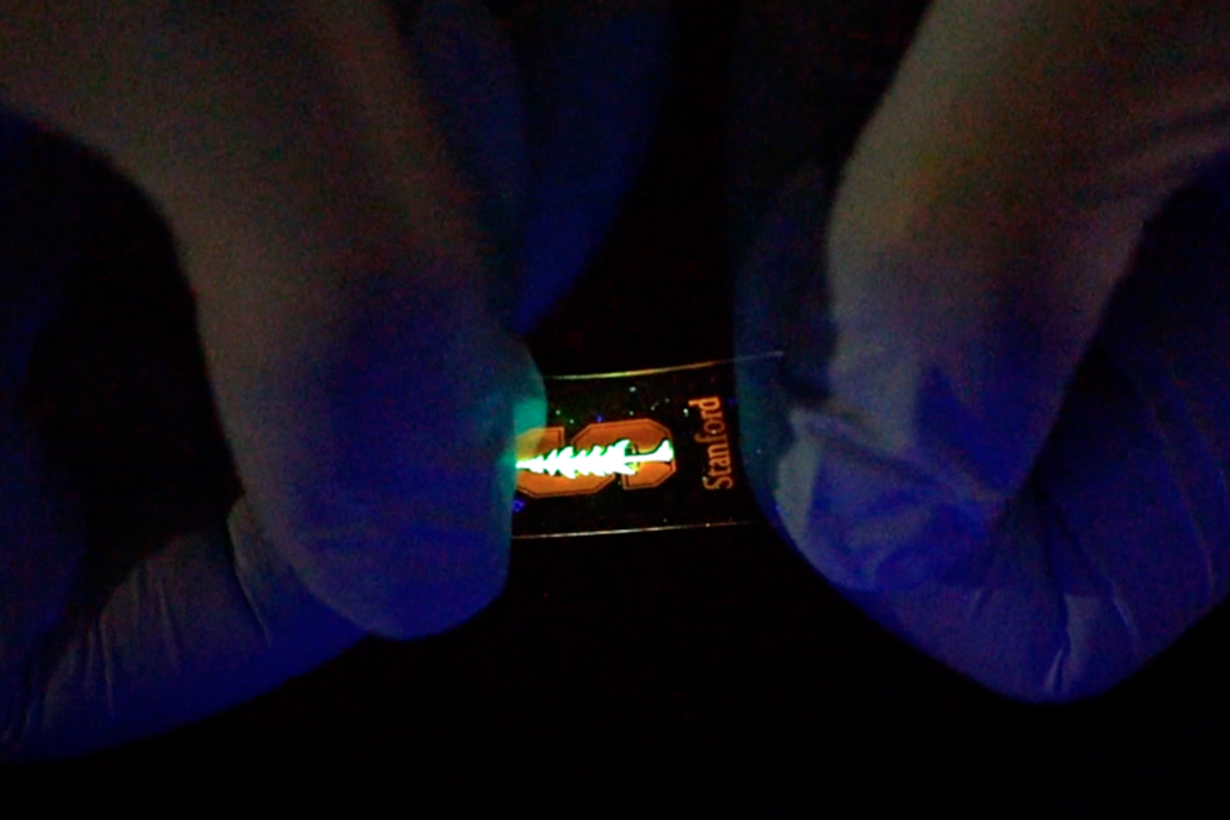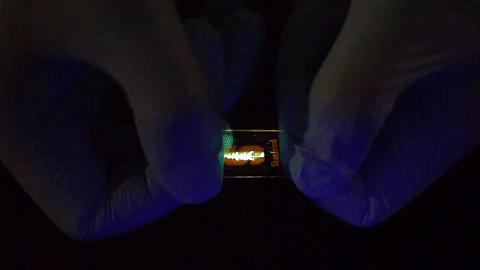CLOSE
About Elements
TANAKA is a leading company in the field of precious metals.
Advanced materials and solutions that support societal progress, the development stories behind them, the voices of engineers, and our management philosophy and vision—
Elements is an online media platform that shares insights that lead to a better society and a more prosperous future for the planet under the slogan “Mastering Precious Metals.”

Stanford engineers made a tiny LED display that stretches like a rubber band

Stanford Engineers made this plastic film into a mini LED display. Bao Group Research Lab / Stanford University
The screen on your smartphone or television is a rigid object that definitely isn’t meant to stretch. But engineers from Stanford University may have figured out the first steps towards making a stretchy LED screen, and their new research is exploring how they might go about creating interactive displays that could easily be part of Elastigirl’s supersuit from The Incredibles.
Unlike traditional LED displays, which are made up of liquid crystals encapsulated in a rigid casing, this LED screen, described in detail in the journal Nature on Wednesday, is wholly made out of a rubber-band-like polymer material.
Here’s what to know about the new research.
[Related: This wearable fabric microphone can listen to the world—and your body]
How a traditional LED screen works
LED stands for light emitting diode, and LED electronics work in similar ways. The typical LED screens on a TV or a smartphone have several layers sandwiched into a display matrix, which has to contain the liquid crystal layer between two electrode layers, some light polarizing layers, and a RGB color mask that sits between the crystal layer and the viewer.
The way the layers are constructed allow for a complex series of reactions to take place, in the end, producing bright pictures. Of the two electrode layers in the display, one produces positive charges, or holes, and one produces electrons, or negative charges. These charges start moving across the different layers in the presence of an electric field, explains Zhenan Bao, a chemical engineering professor at Stanford University and an author on the paper in Nature. “When the positive charge, also called holes, and the electron, find each other, they will combine into some kind of excited-state molecule,” she says. “Then, when [that excited molecule comes down] to a ground state, which is more stable, light [in the form of a photon] will be emitted.”
The basic principle in this setup is that the voltage-controlled liquid crystal can manipulate the pathway, direction and intensity of light at the pixel level (think of pixels like the teeny building blocks of the screen). Each pixel contains three sub-pixels, which have color filters over them, usually in red, green and blue, which can be output in different combinations to make the pixel block different colors. Zoom out, and the mass of colored pixels can form a picture.
Most of the screens that are currently being used on computers and TVs are made of liquid crystal. “They don’t give off light. There’s a backlight [which contains an LED strip], and in front of the backlight is the liquid crystal. A lot of the light is being basically blocked,” Bao says. “Only part of the light can come through. So it consumes more energy and also the switching speed (which dictates how quickly the pictures on the screen can change) is relatively slow.”
Another downside of these screens is that they’re rigid and brittle, Bao notes, mostly because the substrate is made of glass, and the materials that go into the light emitting diode will also break apart if you try to bend it or stretch it.

Bao Group Research Lab / Stanford University
What to know about the new stretch concept
“What we’re doing here is trying to make a new type of display that you can bend, fold, change shape and still show the images,” Bao says. Having a screen that can change shape will allow it to fit onto the contours of soft or uneven surfaces. In their experiment, they stress-tested it by stretching it and poking it with a pen, and it held up well.
Bao and her team were tasked with the job of making all the components of this screen elastic. “We developed a stretchable conducting polymer that can be used for the two electrodes. But since one electrode needs to allow holes to go in, and the other electrode needs to allow electrons to go in, we also need to facilitate transport through the layers,” Bao says. “The light emitting material here needs to be stretchable but it also needs to give off a lot of light. We want a bright display.”
She and her colleagues found a way to combine the different hard and soft plastic materials together so that the light emitting polymer forms nanofiber structures, which helps the electrons and holes find each other. “If they can’t find each other, we won’t get light out,” she says. “This nanostructure makes a continuous pathway. And also, we found that by forming these nanofiber-like structures, it removes some of the imperfections that used to be present in the light emitting polymer. We saw that more light can get out in the stretchable material compared to the non-stretchable version.”
They were able to form this nanostructure with green, red, and blue light emitting polymers, which are the basic colors needed to make a full color display. After that, it was mainly an engineering problem of figuring out a way to stably stack the various layers of the screen together to make the display. Their final product is made up of two substrate layers on the outside, two electrode layers within that, followed by two charge transporting layers, and the light emitting layer in the center.
For this prototype, the team demonstrated that their screen could hold a static image. To make a screen that can change images, they would need to incorporate some sort of motor that can power it. “The type of screen that we have is very low resolution. This paper is mainly about the discovery of the materials and how we made pixels of the display,” says Bao. “But the pixels are still quite large. The next step is we need to make them higher resolution and we also need to make them last longer.”
In its present state, this first-generation stretchy screen can emit light in high nitrogen environments for days. Once it’s exposed to normal air, the light can only last a few hours.
“We still don’t have good material that can block oxygen and moisture from entering into the light emitting polymer, [which] quenches the light and makes the display dimmer over time,” Bao says. “For the OLED displays we use today, the device inside also only operates under nitrogen. But they found a good encapsulation material that can block oxygen and moisture. That’s an important part for the display to be useful practically.”
The post Stanford engineers made a tiny LED display that stretches like a rubber band appeared first on Popular Science.
This article originally appeared on Popular Science
This article was written by Charlotte Hu from Popular Science and was legally licensed through the Industry Dive Content Marketplace. Please direct all licensing questions to legal@industrydive.com.
![]()







